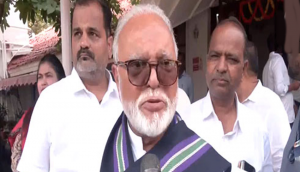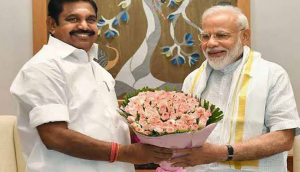Despite Kathua, polarisation, PDP-BJP coalition looks strong. Here's why

As the Jammu and Kashmir Cabinet reshuffle brought in new ministerial faces, including new Deputy Chief Minister Kavinder Gupta, all seemed well with the coalition between Bharatiya Janata Party and People's Democratic Party. But Gupta struck a discordant note, terming the Kathua rape and murder “a minor incident” – displaying yet again the ideological strain between the parties that keeps betraying itself at the unlikeliest of occasions.
It also gives a measure of how the tension would be like when the situation isn't going well, for example, during the deeply polarising three-month-long campaign in support of the accused in the Kathua crime.
And this, at times, does push the alliance to breaking point.
Only a fortnight ago, on 14 April, the ruling PDP had gone into a huddle in Srinagar, following renewed complications in its coalition with the BJP over Kathua. The saffron party's attitude was ambivalent towards the accused; some of its leaders still backing the protests in Jammu in favour of a probe by the Central Bureau of Investigation, had become a source of embarrassment for the PDP in Kashmir Valley, its core constituency.
The PDP was also sore about the continuing killings of the civilians in protests, seen largely as the outcome of the Centre’s iron-fist approach towards the Valley.
Several PDP leaders spoke in favour of a break-up with the BJP to arrest the detrimental fallout of the alliance on the political base of the party. But in the end the party resolved to continue with the coalition after senior leaders cited the resignations of two BJP ministers – Chaudary All Singh and Chander Prakash Ganga – who had earlier participated in the rally of the Hindu Ekta Manch in favour of the accused.
The coalition partners have now reconciled again, forced by the inherent dynamics of J&K politics, compulsions of their respective electoral mandates and of course the mutual convenience.
The truth is that the PDP-BJP coalition has completed four years in power.
The first year was under the chief ministership of the late Mufti Mohammad Sayeed – a year of relentless political tug-of-war which often pushed the state to the brink.
In its second wind under Mehbooba Mufti, the turmoil has been no less. After unsuccessfully trying to hold the BJP to its terms in the Agenda of Alliance during the three months of her conditional refusal to join it, Mehbooba reconciled to the state of affairs. Ever since she has, more or less, submitted to the BJP’s belligerent politics and at times ideological overreach. In the process her political stock has been declining.
The BJP, backed by its government in New Delhi, has dictated the state’s policies in the past four years, and its agenda and discourse: on the Kashmir solution, a strict integrationist policy has replaced the PDP's pitch for the resolution of Kashmir, which in rhetorical terms sometimes bordered on soft separatism.
The BJP has hijacked the local political discourse by ensuring that a steady stream of issues and controversies are initiated and controlled by it even on issue as indefensible as the rape and murder of the eight-year-old girl. This, in turn, has squeezed the play of not only the separatist narrative but also that of the local mainstream politics.
And as for the development of the state, a prospect that had lent the PDP-BJP coalition it's biggest rationale, only around Rs 14,000 crore of the much-hyped Rs 80,000-crore package announced by Prime Minister Narendra Modi in November 2015 has been released in the three years since.
Where does the coalition go from here? Nothing can be said with certainty. After having been together for four years and endured the consequences of their ideological divergence – albeit predominantly to the detriment of the PDP – there's no reason that it should break. More so, when there is little to gain from such a break-up. Chief Minister Mehbooba Mufti's political standing has plunged to an extent where it cannot even hope to claim political martyrdom.
There is another problem and that is, the TINA factor. The PDP often presses it in its defence: There Is No Alternative.
“Whether the coalition will last is not the right question. Whether there is a substitute in the system is,”Works Minister and J&K Government spokesman Naeem Akhtar told Catch. “We have to bear in mind the complexities of the state. Unless you give every region, every community a sense of participation and a consequent sense of empowerment, there's no other option to go about this".
When asked if the BJP’s losing the 2019 national election make a difference to the PDP’s preferences, Akhtar said the PDP was looking forward to Modi winning again. He said even if Modi were to lose the poll, it won't impact the J&K coalition.
“This is a state arrangement. Truth is you can't keep one region out of the power structure. We have a mandate for six years. The mandate is such that it is region-specific for all parties. Can you afford to keep anybody out of the system?” Akhtar said.
Though traditionally the electoral arithmetic arising from the demographics guaranteed the Valley its political primacy, the existing political mandate has upset the chessboard. In the last Assembly election, the majority Hindu community in Jammu voted en masse for the BJP, giving it 25 out of the province’s 37 seats, thus making the Hindu nationalist party a significant political actor in the state and a necessary part of the state’s governing structure.
But in the Valley, the much-fancied PDP pulled off just 25 of the 46 seats, with others being divided up inequitably among the National Conference, Congress, People’s Conference, Awami Itihad Party and the Communist Party of India (Marxist). The PDP was helped along to its final tally of 28 by its wins in three seats from the Muslim-majority areas of Jammu.
Akhtar denied that the BJP was running away with the political agenda in the state. “It varies from event to event. And some things are inbuilt into the political structure of the state. You have to see it in its perspective. You can’t take it away from its historical background,” Akhtar said adding the PDP had ensured it doesn’t compromise on its own ideology and had taken steps to defend it. “There is now only one voice in the country which seeks peace with Pakistan and which is that of Mehbooba Mufti. Even liberal political voices in the country don’t ask for it”.
And to the question that the BJP had yet to fulfil its commitments in the Agenda of Alliance, Akhtar agreed that the “eco-system”, which was necessary for such a fulfilment had not been created.
“Kashmir is what it was pre-2003. But during Vajpayee regime, the atmosphere had changed, ecosystem had changed. There was peace. There was exchange of delegations. It was trade. It was opening of routes. That process has halted”.
Despite such issues, Akhtar said the coalition will go on as there is no alternative. But with the country due to go into an election mode in a few months, Kashmir could become a hunting ground for the political parties looking for issues to rally public support in the rest of the country. And this could include attempts at polarisation too. So, the task of the PDP to hang on to the BJP might get only tougher.






![BJP's Kapil Mishra recreates Shankar Mahadevan’s ‘Breathless’ song to highlight Delhi pollution [WATCH] BJP's Kapil Mishra recreates Shankar Mahadevan’s ‘Breathless’ song to highlight Delhi pollution [WATCH]](https://images.catchnews.com/upload/2022/11/03/kapil-mishra_240884_300x172.png)

![Anupam Kher shares pictures of his toned body on 67th birthday [MUST SEE] Anupam Kher shares pictures of his toned body on 67th birthday [MUST SEE]](https://images.catchnews.com/upload/2022/03/07/Anupam_kher_231145_300x172.jpg)






